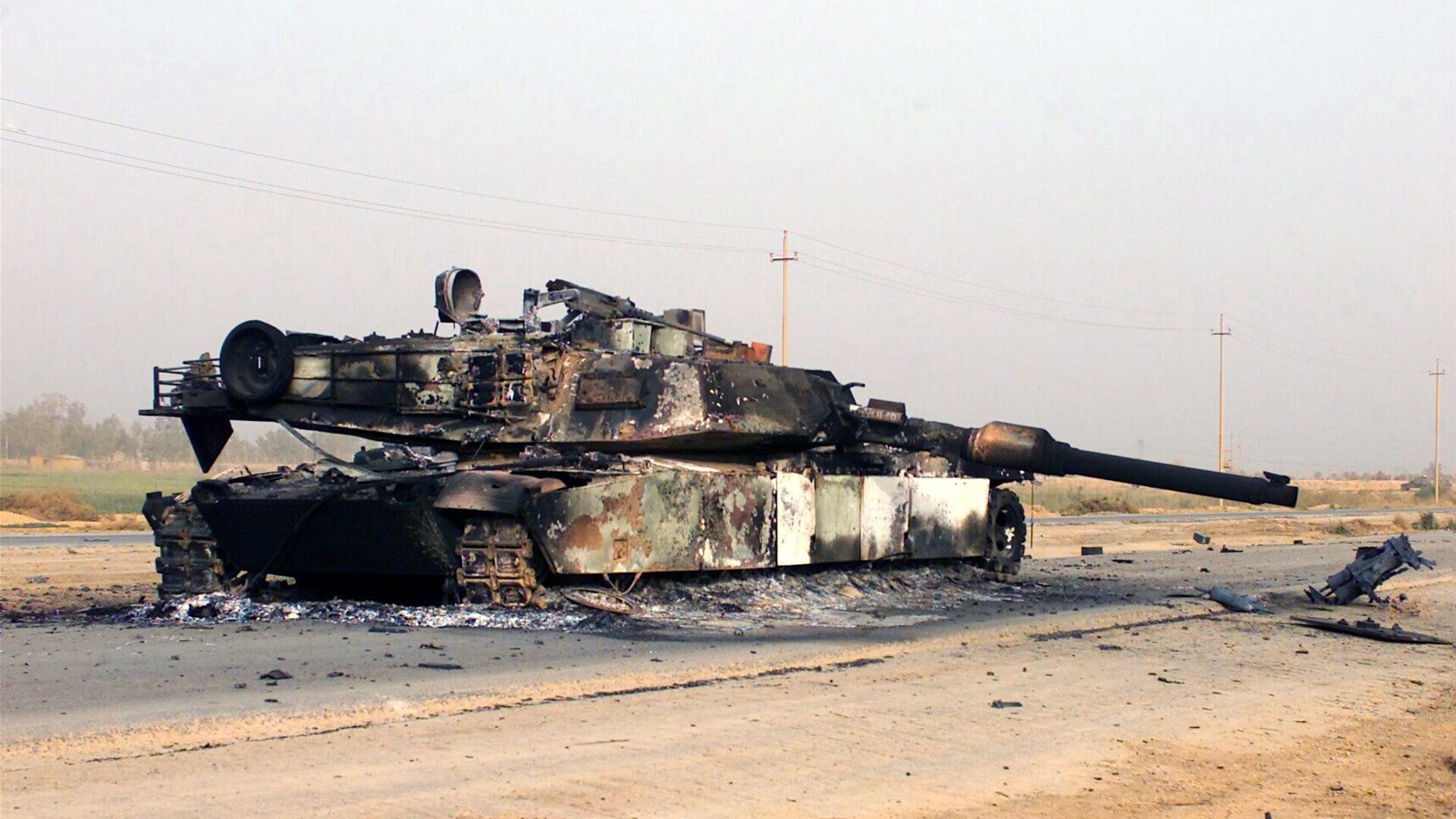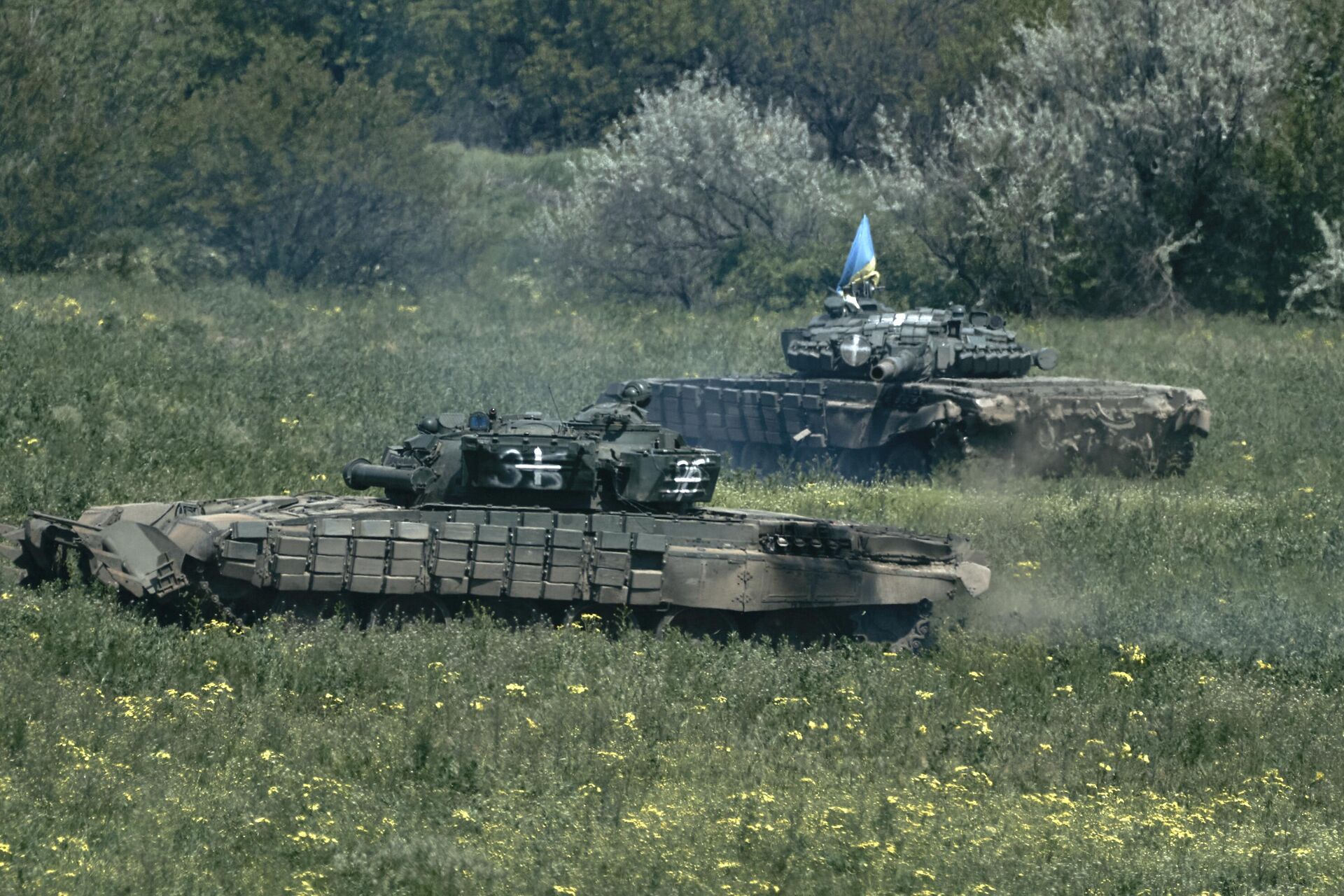https://sputnikglobe.com/20231024/let-the-abrams-hunt-begin-how-russian-forces-prepare-for-latest-wonder-weapon-1114427073.html
Let the Abrams Hunt Begin: How Russian Forces Prepare for Latest 'Wonder Weapon'
Let the Abrams Hunt Begin: How Russian Forces Prepare for Latest 'Wonder Weapon'
Sputnik International
Having finally received the 'promised gifts' from the White House in late September, the Kiev regime is banking on M1 Abrams tanks - yet another 'wonder weapon' from the West to fight against Russia.
2023-10-24T07:07+0000
2023-10-24T07:07+0000
2023-10-24T07:07+0000
russia's special operation in ukraine
ukraine
russia
germany
nato
ukrainian armed forces
lancet
leopard 2
challenger
t-72b3
https://cdn1.img.sputnikglobe.com/img/105858/09/1058580998_0:97:1721:1065_1920x0_80_0_0_311a15de7580d609387e1055e75af6f4.jpg
US Abrams tanks have made their way to Ukraine, nearly four months into Ukraine's "grand counteroffensive," with media sources confirming the delivery of 31 tanks. The exact timeline for their deployment to the front lines remains uncertain. Sputnik examines the role these tanks will play in combat and the views of Russian soldiers.Priority TargetsThe promise of Abrams tanks to the Ukrainians was made earlier this year when NATO announced the creation of a "tank coalition." Using this strategy, the US pressured Germany to agree to export its own Leopard 1 and Leopard 2 heavy tanks to Ukraine and to allow allies to make similar deliveries. At the same time, the UK agreed to donate 14 Challenger 2 tanks, and France provided several dozen AMX-10RC wheeled tanks. When all the agreements were signed, the Americans announced that they would deliver the Abrams tanks last.During the summer counteroffensive, Western armored vehicles did nothing special. Modern Leopards and Challengers fell victim to minefields, were targeted by army aviation, and FPV drones pierced their thin rooftop armor. Artillery fire finished off stationary vehicles. Thanks to the widespread use of drones by the Russian army, all movements were detected in time.It turned out that the rapid advance of armored groups according to NATO standards did not work against deeply entrenched defenses built according to the principles of Soviet fortification science. The Ukrainian forces lost dozens of Western tanks and hundreds of other armored units, but failed to break through the first line of trenches.Realizing that foreign gifts would not help, the Ukrainians changed their tactics, opting for small infantry groups. Western supplies are now used for long-range shooting from concealed positions or direct fire at maximum range. Neither approach is particularly accurate, nor do they seem willing to lose expensive armored vehicles.Reduced CapabilitiesThirty-one Abrams tanks may look impressive on paper. It's almost an American tank battalion. If they were to stack their 60-ton vehicles in a single sector, Russian defenses might struggle.In practice, however, the Ukrainian General Staff abandoned the idea of using large groups of tanks when it became clear that they couldn't cross minefields. It's unlikely that Washington wants its tanks to become "advertising" by burning somewhere in the fields of Zaporozhye.In addition, Kiev will receive the M1A1 modification, which was relevant during the Cold War and Operation Desert Storm. The current technical condition of these tanks is a big question.The armor of the early Abrams models is resistant to the anti-tank weapons of the late 1980s. Over time, the Russian Army has developed means to engage more advanced targets. These include the Kornet anti-tank guided missile, new sub-caliber armor-piercing rounds, and advanced ammunition for anti-tank grenade launchers.Furthermore, some critical technologies are missing from the donated equipment. The Pentagon doesn't want military secrets falling into the wrong hands. So they removed the "hallmark" - enhanced uranium armor components that made the armor almost impenetrable from the front. They also did the same with the terminals responsible for building a battle network.In essence, the Ukrainian Armed Forces will receive three platoons of tanks comparable in characteristics and combat capabilities to the 1989 Soviet T-72B tanks. The M1A1 has little chance against more modern Russian tanks such as the T-72B3, T-80BVM and T-90M. It is also quite vulnerable to outdated Soviet anti-tank missile systems, as experience in Iraq and Yemen has shown.In addition, the M1A1 Abrams is challenging to use with other types of tanks. Because of its gas turbine engine, it requires special logistics and maintenance. First, it consumes a considerable amount of fuel — 230 liters per hour of cross-country driving, which is quite significant. Second, only the Americans have experience in maintaining such engines. Other NATO vehicles are equipped with diesel engines.Threat From the AirThe M1A1 Abrams is a classic tank of Western design, with accurate long-range artillery, modern observation equipment, thick front armor, and very weak side and rear armor. Even a sub-caliber armor-piercing round from a 30-millimeter BMP-2 gun can penetrate the side armor of an American tank. Therefore, it is unlikely that the Ukrainian Armed Forces will use Abrams in frontal attacks.More likely, they will distribute them throughout the front line and use them as snipers. However, such tactics will not protect them from drones, which have become one of the most effective means of countering armored vehicles.According to him, the tactical and technical characteristics of this tank are well known, and the vulnerable areas have been studied on diagrams. Therefore, such equipment will not be something unexpected, claims Shket.Drones are not the only threat. The Ukrainian armed forces' biggest losses of Western armored vehicles come from Russian mines. Tanks or IFVs are blown up, losing mobility, and later they are finished off by artillery.Many vehicles have been hit by Ka-52 and Mi-28N attack helicopters armed with heavy anti-tank guided missiles such as Vikhr (lit. Whirlwind), Ataka (lit. Attack) and the latest LMUR (Light Multipurpose Guided Rocket). Their power is enough to destroy an M1A1 with a single hit to almost any part.To use Abrams effectively, Ukraine needs air superiority. The earliest they can try to achieve this is in the spring of 2024, when they will receive F-16 fighter jets. There is a possibility that they will keep the battalion of American tanks until then. Nevertheless, these tanks have not become a "wonder weapon" one way or another.
https://sputnikglobe.com/20230930/scott-ritter-abrams-tanks-will-become-mobile-steel-coffins-for-ukrainian-crews-1113821460.html
ukraine
russia
germany
kiev
Sputnik International
feedback@sputniknews.com
+74956456601
MIA „Rossiya Segodnya“
2023
Andrey Kots
https://cdn1.img.sputnikglobe.com/img/07e7/09/0d/1113345217_428:0:2132:1704_100x100_80_0_0_572c3cfc2b7e5fdab0f340359bd4760b.jpg
Andrey Kots
https://cdn1.img.sputnikglobe.com/img/07e7/09/0d/1113345217_428:0:2132:1704_100x100_80_0_0_572c3cfc2b7e5fdab0f340359bd4760b.jpg
News
en_EN
Sputnik International
feedback@sputniknews.com
+74956456601
MIA „Rossiya Segodnya“
Sputnik International
feedback@sputniknews.com
+74956456601
MIA „Rossiya Segodnya“
Andrey Kots
https://cdn1.img.sputnikglobe.com/img/07e7/09/0d/1113345217_428:0:2132:1704_100x100_80_0_0_572c3cfc2b7e5fdab0f340359bd4760b.jpg
abrams tanks for ukraine, how much abrams tanks us sent to ukraine, us spending on ukraine, how much does us spend on ukraine
abrams tanks for ukraine, how much abrams tanks us sent to ukraine, us spending on ukraine, how much does us spend on ukraine
Let the Abrams Hunt Begin: How Russian Forces Prepare for Latest 'Wonder Weapon'
Having finally received the 'promised gifts' from the White House in late September, the Kiev regime is counting on yet another 'wonder weapon' from the West. But will it help the Ukrainian army, given that there is simply no air cover for M1 Abrams tanks, while F-16s are not expected until spring 2024 at the earliest?
US Abrams tanks have made their way to Ukraine, nearly four months into Ukraine's "grand counteroffensive," with media sources confirming the delivery of 31 tanks. The exact timeline for their deployment to the front lines remains uncertain. Sputnik examines the role these tanks will play in combat and the views of Russian soldiers.
The promise of
Abrams tanks to the Ukrainians was made earlier this year when NATO announced the creation of a "tank coalition." Using this strategy, the US pressured Germany to agree to export its own
Leopard 1 and Leopard 2 heavy tanks to Ukraine and to allow allies to make similar deliveries. At the same time, the UK agreed to donate 14 Challenger 2 tanks, and France provided several dozen AMX-10RC wheeled tanks. When all the agreements were signed, the Americans announced that they would deliver the Abrams tanks last.
During the summer counteroffensive, Western armored vehicles did nothing special. Modern Leopards and Challengers fell victim to minefields, were targeted by army aviation, and FPV drones pierced their thin rooftop armor. Artillery fire finished off stationary vehicles. Thanks to the widespread use of drones by the Russian army, all movements were detected in time.

30 September 2023, 13:00 GMT
It turned out that the rapid advance of armored groups according to NATO standards did not work against deeply entrenched defenses built according to the principles of Soviet fortification science. The Ukrainian forces lost dozens of Western tanks and hundreds of other armored units, but failed to break through the first line of trenches.
Realizing that foreign gifts would not help, the Ukrainians changed their tactics, opting for small infantry groups. Western supplies are now used for long-range shooting from concealed positions or direct fire at maximum range. Neither approach is particularly accurate, nor do they seem willing to lose expensive armored vehicles.
Thirty-one Abrams tanks may look impressive on paper. It's almost an American tank battalion. If they were to stack their 60-ton vehicles in a single sector, Russian defenses might struggle.
In practice, however, the Ukrainian General Staff abandoned the idea of using large groups of tanks when it became clear that they
couldn't cross minefields. It's unlikely that Washington wants its tanks to become "advertising" by burning somewhere in the fields of Zaporozhye.
In addition, Kiev will receive the M1A1 modification, which was relevant during the Cold War and Operation Desert Storm. The current technical condition of these tanks is a big question.
The armor of the early Abrams models is resistant to the anti-tank weapons of the late 1980s. Over time, the Russian Army has developed means to engage more advanced targets. These include the Kornet anti-tank guided missile, new sub-caliber armor-piercing rounds, and advanced ammunition for anti-tank grenade launchers.
Furthermore, some critical technologies are missing from the donated equipment. The Pentagon doesn't want military secrets falling into the wrong hands. So they removed the "hallmark" - enhanced uranium armor components that made the armor almost impenetrable from the front. They also did the same with the terminals responsible for building a battle network.
In essence, the Ukrainian Armed Forces will receive three platoons of tanks comparable in characteristics and combat capabilities to the 1989 Soviet T-72B tanks. The M1A1 has little chance against more modern Russian tanks such as the T-72B3, T-80BVM and T-90M. It is also quite vulnerable to outdated Soviet anti-tank missile systems, as experience in Iraq and Yemen has shown.
In addition, the M1A1 Abrams is challenging to use with other types of tanks. Because of its gas turbine engine, it requires special logistics and maintenance. First, it consumes a considerable amount of fuel — 230 liters per hour of cross-country driving, which is quite significant. Second, only the Americans have experience in maintaining such engines. Other NATO vehicles are equipped with diesel engines.
The M1A1 Abrams is a classic tank of Western design, with accurate long-range artillery, modern observation equipment, thick front armor, and very weak side and rear armor. Even a sub-caliber armor-piercing round from a 30-millimeter BMP-2 gun can penetrate the side armor of an American tank. Therefore, it is unlikely that the Ukrainian Armed Forces will use Abrams in frontal attacks.
More likely, they will distribute them throughout the front line and use them as snipers. However, such tactics will not protect them from drones, which have become one of the most effective means of countering armored vehicles.
"We are looking forward to these tanks and are ready for them," says the operator of a Lancet kamikaze drone with the call sign Shket (lit. Lad), who is fighting on the southern Donetsk front. "We already have Leopards in our trophy. Abrams' probably won't be much different. The Lancet hits from above, and the top turret armor of all tanks is weak. The American has a massive 'back of the head' — the rear ammo compartment. This should make a good target."
According to him, the tactical and technical characteristics of this tank are well known, and the vulnerable areas have been studied on diagrams. Therefore, such equipment will not be something unexpected, claims Shket.
"After all, the military schools trained us to confront it specifically," he added.
Drones are not the only threat. The Ukrainian armed forces' biggest losses of Western armored vehicles come from Russian mines. Tanks or IFVs are blown up, losing mobility, and later they are finished off by artillery.
Many vehicles have been hit by Ka-52 and Mi-28N attack helicopters armed with heavy anti-tank guided missiles such as Vikhr (lit. Whirlwind), Ataka (lit. Attack) and the latest LMUR (Light Multipurpose Guided Rocket). Their power is enough to destroy an M1A1 with a single hit to almost any part.
To use Abrams effectively, Ukraine needs air superiority. The earliest they can try to achieve this is in the spring of 2024, when they will receive F-16 fighter jets. There is a possibility that they will keep the battalion of American tanks until then. Nevertheless, these tanks have not become a "wonder weapon" one way or another.





